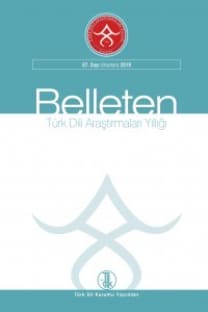Türkçe bilgisayarlı dil bilimi çalışmalarında his analizi
Bilgisayarlı dil bilimi, metinlerde his analizi, dil bilimi
Emotion analysis in Turkish computational linguistics studies
Computational linguistics, emotion analysis in texts,
___
- Abdaoui, A., Azé, J., Bringay, S. ve Poncelet, P. (2017). FEEL: a French expanded emotion lexicon. Language Resources and Evaluation, 51(3), 833–855. doi:10.1007/s10579-016-9364-5
- Abdul-Mageed, M., Alhuzli, H., Elhija, D. A., Diab, M. ve Duaa’Abu Elhija, M. D. (2016). DINA: A multidialect dataset for arabic emotion analysis. The 2nd workshop on Arabic corpora and processing tools içinde (s. 29).
- Aggarwal, C. C. ve Zhai, C. (2012). A survey of text classification algorithms. Mining text data içinde (ss. 163–222). Springer.
- Akba, F., Uçan, A., Sezer, E. ve Sever, H. (2014). Assessment of feature selection metrics for sentiment analyses: Turkish movie reviews. 8th European Conference on Data Mining 2014, 191 (2002), 180–184.
- Akın, A. A. ve Akın, M. D. (2007). Zemberek, an open source Nlp framework for Turkic Languages. Structure, 10, 1–5. doi:10.1.1.556.69
- Alm, C. O., Roth, D. ve Sproat, R. (2005). Emotions from text: machine learning for text-based emotion prediction. Proceedings of the conference on human language technology and empirical methods in natural language processing içinde (ss. 579–586).
- Aman, S. ve Szpakowicz, S. (2007). Identifying expressions of emotion in text. International Conference on Text, Speech and Dialogue içinde (ss. 196–205).
- Bai, X. (2011). Predicting consumer sentiments from online text. Decision Support Systems, 50(4), 732–742.
- Bandhakavi, A., Wiratunga, N., Padmanabhan, D. ve Massie, S. (2017). Lexicon based feature extraction for emotion text classification. Pattern Recognition Letters, 93, 133–142. doi:10.1016/j.patrec.2016.12.009
- Boynukalin, Z. ve Karagoz, P. (2013). Emotion analysis on Turkish texts. Information Sciences and Systems 2013 içinde (ss. 159–168). Springer.
- Briciu, A. ve Lupea, M. (2017). RoEmoLex - a Romanian emotion lexicon. Studia Universitatis Babeș-Bolyai Informatica, 62(2), 45–56. doi:10.24193/subbi. 2017.2.04
- Demirci, S. (2014). Emotion analysis on Turkish tweets. Middle East Technical University.
- Dwi Prasetyo, N. ve Hauff, C. (2015). Twitter-based election prediction in the developing world. Proceedings of the 26th ACM Conference on Hypertext & Social Media içinde (ss. 149–158).
- Ekman, P. (1972). Universals and cultural differences in facial expressions of emotion. Nebraska Symposium on Motivation içinde (C 19, ss. 207–282). Ekman, P. (1992). An argument for basic emotions. Cognition & emotion, 6(3–4), 169–200.
- Ekman, P. ve Friesen, W. V. (1976). Measuring facial movement. Environmental Psychology and Nonverbal Behavior, 1(1), 56–75. doi:10.1007/BF01115465
- Eryigit, G. (2014). ITU Turkish NLP web service. Proceedings of the Demonstrations at the 14th Conference of the European Chapter of the Association for Computational Linguistics içinde (ss. 1–4).
- Hakkani-Tür, D. Z., Oflazer, K. ve Tür, G. (2002). Statistical morphological disambiguation for agglutinative languages. Computers and the Humanities, 36(4), 381–410.
- Hochreiter, S. ve Schmidhuber, J. J. (1997). Long short-term memory. Neural Computation, 9(8), 1–32.
- Ilgen, B., Adali, E. ve Tantug, A. C. (2016). Exploring feature sets for Turkish word sense disambiguation. Turkish Journal of Electrical Engineering & Computer Sciences, 24(5), 4391–4405.
- Mikolov, T., Corrado, G., Chen, K., Dean, J., Corrado, G. ve Dean, J. (2013).
- Efficient estimation of word representations in vector space. Proceedings of the International Conference on Learning Representations (ICLR 2013), 1–12.
- Mohammad, S. M. ve Bravo-Marquez, F. (2017). Emotion intensities in tweets. SEM 2017: The Sixth Joint Conference on Lexical and Computational Semantics içinde (ss. 65–77).
- Mohammad, S. M. ve Turney, P. D. (2013). Crowdsourcing a word-emotion association lexicon. Computational Intelligence, 29(3), 436–465. doi:10.1111/ j.1467-8640.2012.00460.x
- Naderalvojoud, B., Ucan, A. ve Akcapinar Sezer, E. (2018). HUMIR at IEST- 2018: Lexicon-sensitive and left-right context-sensitive bi-lstm for implicit emotion recognition. Proceedings of the 9th Workshop on Computational Approaches to Subjectivity, Sentiment and Social Media Analysis içinde (ss. 182–188). Association for Computational Linguistics.
- Oflazer, K. (1994). Two-level description of Turkish morphology. Literary and linguistic computing, 9(2), 137–148.
- Oflazer, K. ve Saraçlar, M. (2018). Turkish natural language processing. Springer.
- Pang, B., Lee, L. ve Vaithyanathan, S. (2002). Thumbs up? Sentiment classification using machine learning techniques. Proceedings of the ACL-02 Conference on Empirical Methods in Natural Language Processing - Volume 10 içinde (ss. 79– 86). Association for Computational Linguistics. doi:10.3115/1118693.1118704 Plutchik, R. (1991). The emotions. University Press of America.
- Smailovic, J., Grcar, M., Lavrac, N. ve Znidarsic, M. (2013). Predictive sentiment analysis of tweets: A stock market application. International Workshop on Human- Computer Interaction and Knowledge Discovery in Complex, Unstructured, Big Data içinde (ss. 77–88).
- Tocoglu, M. A. ve Alpkocak, A. (2018). TREMO: A dataset for emotion analysis in Turkish. Journal of Information Science, 44(6), 848–860.
- Tocoglu, M. A. ve Alpkocak, A. (2019). Lexicon-based emotion analysis in Turkish. Turkish Journal Of Electrical Engineering & Computer Sciences, 27(2), 1213–1227.
- Tocoglu, M. A., Ozturkmenoglu, O. ve Alpkocak, A. (2019). Emotion analysis from Turkish tweets using deep neural networks. IEEE Access, 7, 183061– 183069. doi:10.1109/ACCESS.2019.2960113
- Turney, P. D. (2002). Thumbs up or thumbs down? Semantic orientation applied to unsupervised classification of reviews. Proceedings of the 40th Annual Meeting on Association for Computational Linguistics içinde (ss. 417–424). Association for Computational Linguistics. doi:10.3115/1073083.1073153
- Wallbott, H. G. ve Scherer, K. R. (1986). How universal and specific is emotional experience? Evidence from 27 countries on five continents. Information (International Social Science Council), 25(4), 763–795.
- Wiebe, J., Wilson, T. ve Cardie, C. (2005). Annotating expressions of opinions and emotions in language. Language resources and evaluation, 39(2–3), 165–210.
- ISSN: 0564-5050
- Yayın Aralığı: 2
- Başlangıç: 1953
- Yayıncı: Türk Dil Kurumu
Ebu’n-nasr Sâmânî ve 19. yüzyılda yazılmış bir Uveysi tezkiresi üzerine
Yesevi şairi Şems-i Asi’nin Yetimnamesi
Burdur ili ağızlarının ortak karakteristik ses bilgisi özellikleri
Eski Uygurca Buddhāvataṁsaka-sūtra tefsirine ilişkin fragmanlar (13, 14 ve 19. Yapraklar)
Türkçe bilgisayarlı dil bilimi çalışmalarında his analizi
Ebru AKÇAPINAR SEZER, Alaettin UÇAN
Klasik Türk edebiyatının söz algısının gösterge bilimi açısından değerlendirilmesi
